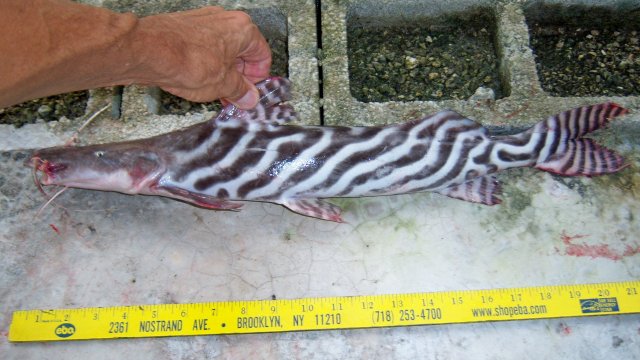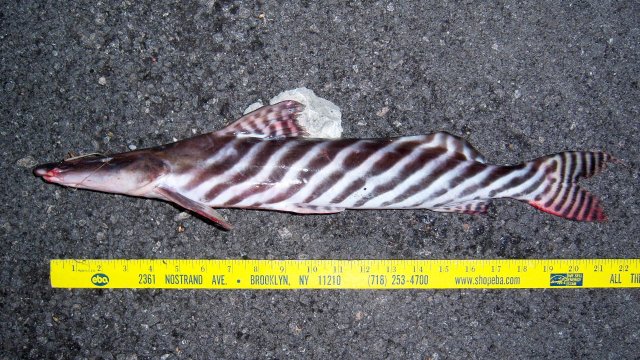Minus two more tigs in the 1800 gal. Same symptoms. All the damage in the photos below is self-inflicted when dying, spinning, ramming into things.
Down to 1 remaining tig.


 Yaponchik
Thank you for your post, brother.
Yaponchik
Thank you for your post, brother.
In our experience, piraiba are hardier to the pathogen spectrum we have in our water, so I am not surprised your/your friend's piraiba could handle what jur and tig couldn't. Exact same we see here.
The high hardness and pH I would suspect cause a constant stress on Amazonian fish like the Brachyplatystoma, which are far not the hardiest and most adaptable.
Absolutely agreed on the need for UV sanitization of water. I've become firmly convinced! I am considering this in earnest, especially now, having lost so many precious, show kind and size fish. Up until now, we have not used UV sanitization on our water. Yes, our water is 85% RO with 15% raw well mixed in. But the bacterial killer lives in our tanks+15K filter system and I am pretty sure it came with other fish, most likely in 2018 with the walking catfish from the wild, who were undertreated in QT. The 26K system of the two 4500's, one 1800, and the 15K sump hosts the majority of larger rescue fish that come and go. No surprise, with my lazy man QT procedures, that we have been losing precious, rare fish (while most of the cheap and hardy fish remain ok). But most of all since 2018. Until then, it had been far better.
Yes, I am not saying it was the columnaris or only columnaris or the columnaris was the primary cause, not secondary or tertiary. Some fish we have lost in 2018 and since then showed symptoms consistent with columnaris and some didn't. Columnaris BTW is a complex animal and has several known strains, acting quite differently.
Yes, my gut feeling says the reason #1 is that the tigs (and their tank mates) were killed by the bacteria, and the stress was only a compounding factor, I suspect a mild one at best.
A less likely reason is dirty 15K sump and as a result a high bacterial count in water column, but after I cleaned the 15K sump thoroughly twice over one year, there was no improvement whatsoever. Thus, I am inclined to discard this as the primary cause. Again, a compounding factor it may be. I have planned to make a rearrangement in the sump, take out half the shade cloth media to make the hiding of detritus and bacteria harder and the vacuuming of the sump easier and faster and will continue cleaning the sump more frequently.
I also am looking into the UV with humongous help from F fishdance . A turn key it'd be $10K-$20. As a DIY, I might get away with several thousand $.
Down to 1 remaining tig.


In our experience, piraiba are hardier to the pathogen spectrum we have in our water, so I am not surprised your/your friend's piraiba could handle what jur and tig couldn't. Exact same we see here.
The high hardness and pH I would suspect cause a constant stress on Amazonian fish like the Brachyplatystoma, which are far not the hardiest and most adaptable.
Absolutely agreed on the need for UV sanitization of water. I've become firmly convinced! I am considering this in earnest, especially now, having lost so many precious, show kind and size fish. Up until now, we have not used UV sanitization on our water. Yes, our water is 85% RO with 15% raw well mixed in. But the bacterial killer lives in our tanks+15K filter system and I am pretty sure it came with other fish, most likely in 2018 with the walking catfish from the wild, who were undertreated in QT. The 26K system of the two 4500's, one 1800, and the 15K sump hosts the majority of larger rescue fish that come and go. No surprise, with my lazy man QT procedures, that we have been losing precious, rare fish (while most of the cheap and hardy fish remain ok). But most of all since 2018. Until then, it had been far better.
Yes, I am not saying it was the columnaris or only columnaris or the columnaris was the primary cause, not secondary or tertiary. Some fish we have lost in 2018 and since then showed symptoms consistent with columnaris and some didn't. Columnaris BTW is a complex animal and has several known strains, acting quite differently.
Yes, my gut feeling says the reason #1 is that the tigs (and their tank mates) were killed by the bacteria, and the stress was only a compounding factor, I suspect a mild one at best.
A less likely reason is dirty 15K sump and as a result a high bacterial count in water column, but after I cleaned the 15K sump thoroughly twice over one year, there was no improvement whatsoever. Thus, I am inclined to discard this as the primary cause. Again, a compounding factor it may be. I have planned to make a rearrangement in the sump, take out half the shade cloth media to make the hiding of detritus and bacteria harder and the vacuuming of the sump easier and faster and will continue cleaning the sump more frequently.
I also am looking into the UV with humongous help from F fishdance . A turn key it'd be $10K-$20. As a DIY, I might get away with several thousand $.








